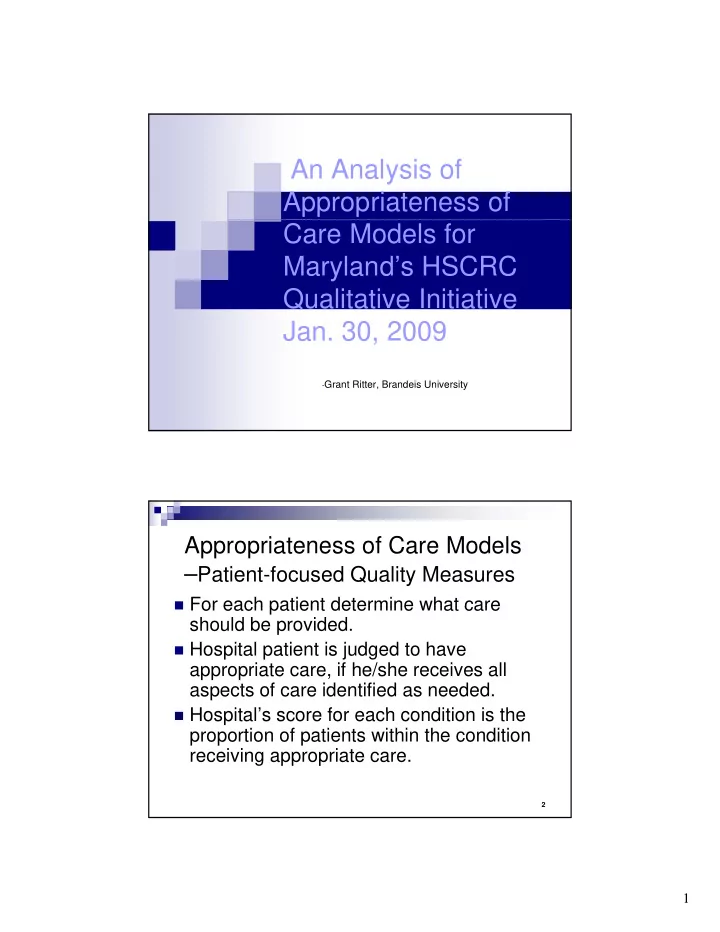

An Analysis of Appropriateness of Care Models for Maryland’s HSCRC Qualitative Initiative J Jan. 30, 2009 30 2009 - Grant Ritter, Brandeis University Appropriateness of Care Models – Patient-focused Quality Measures � For each patient determine what care � For each patient determine what care should be provided. � Hospital patient is judged to have appropriate care, if he/she receives all aspects of care identified as needed. � Hospital s score for each condition is the � Hospital’s score for each condition is the proportion of patients within the condition receiving appropriate care. 2 1
Appropriateness of Care Models Strengths � Patient-centered perspective on quality � Patient-centered perspective on quality � Less chance of “small n” issue � Less problem from topped out measures � Treats all patients equally � If weighting is desired, there would be a clear method for weighting condition-specific scores to get overall composite score. 3 Appropriateness of Care Models Weaknesses � Hard to get the data–currently need to go through a QIO g y g g � Hospital receives same score whether patient misses one service or several. � Hospital score does not immediately indicate where the quality issues lie. � Fewer measures can be combined to create a hospital level composite (4 conditions instead of 19 individual measures) ) � By design Appropriateness of Care Scores will be lower. This may possibly mislead potential patients about the quality of the hospitals in this state. 4 2
Appropriateness of Care Models - Calculations based on 2007 QIO data � Examined appropriateness of care models Examined appropriateness of care models (ACM) for four conditions – AMI, PN, HF, SCIP � Examined models with and without the new measures for PCI (AMI 8a) and SCIP-VTE. � Because these services were performed so infrequently, there was virtually no difference between models including them and not g including them. � Results presented are for the case where the three additional measures are included. 5 Appropriateness of Care Models - Results from the 2007 QIO data � Pages 1-5 gives Hospital ACM scores for AMI, PN, HF, Pages 1 5 gives Hospital ACM scores for AMI, PN, HF, SCIP, and then overall (treating each patient as equal). � Regarding “small n” issue, hospitals need at least 10 patients with the condition in order to report on it. � Only three conditions at two hospitals could not be scored because of this ’10 or more’ criteria. � Results indicate that Maryland hospital have greatly improved their performance on process measures improved their performance on process measures � 2007 ACM scores now have ranges that were achieved by the individual measures only a few years ago. 6 3
Appropriateness of Care Models - Composite Score Approaches � Pages 6-9 gives various approaches to combining the four condition specific ACM scores to derive a overall composite condition-specific ACM scores to derive a overall composite. � Two approaches are based on the previous VBP methodology, wherein meritorious performance (i.e., that which is at or above the 50 th percentile) is awarded a certain number of points. � “VBP Attain” approach uses only 2007 data and bases the award strictly on attainment. � VBP Full” approach makes use of both 2006 and 2007 data and gives the higher of attainment or improvement points. � Two other approaches are based on the new “Relative Quality Index” (RQI). wherein hospitals can receive low points for poor I d ” (RQI) h i h it l i l i t f performance exactly like they receive high points for meritorious performance. � Again, RQI can be implement as attainment only (“RQI attain”) or with both attainment and improvement (“RQI Full”). 7 Appropriateness of Care Models - Results on Composite Scores � Results on pages 6-9 and the four graphs that accompany provide the distributions for the four alternative approaches. � These results indicate that any one of the four approaches could be used: � “VBP Attain” approach is skewed left (low values) and is not normally distributed. However, it clearly has the most room to grow if ACM scores continue to improve. � “VBP Full” (attainment and improvement) and “RQI Attainment” have very similar distributions and both are close to normal. � “RQI Full” is skewed to the right. This is probably not a good choice because it will only move further right in the coming years. 8 4
Recommend
More recommend